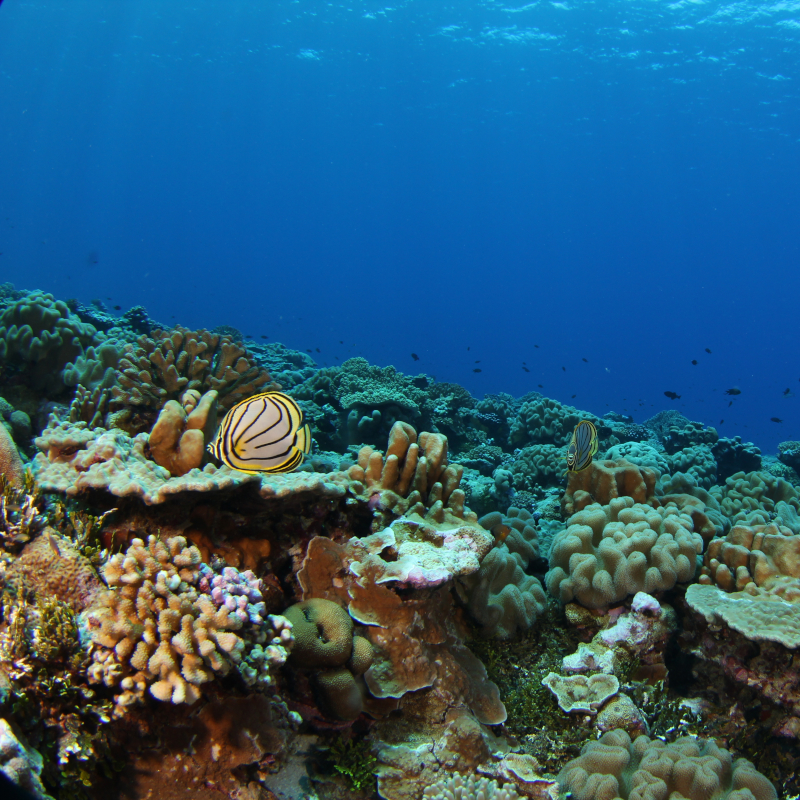Bex J. Turner from the School of Ocean Sciences, Bangor University tells us more about a new study in Proceedings B that tested whether natural depth zonation patterns differed across geographies, and whether and how local human impacts might disrupt these natural zonation patterns. They found evidence of human-disrupted changes to benthic community depth zonation and that benthic community depth zonation did not always occur. Bex tells us more about the paper, the authors and their experience of publishing in the journal.

Coral reef benthic communities are structured by depth-related gradients in biophysical conditions such as light, temperature, wave energy, and food availability. These biophysical drivers lead to what scientists call ‘depth zonation’- a predictable pattern where different benthic groups dominate at different depths. However, the extent to which these patterns vary across geographies, and the degree to which they are modified by local human impacts, remains poorly understood.
To explore this, we analysed data from over 2,200 reef surveys carried out at depths of 0 to 30 m around 33 islands in the Pacific Ocean. Eighteen of these islands were uninhabited, largely untouched by direct human activity. The other 15 were home to people, and the many pressures that come with human presence such as fishing, pollution, or coastal development. We focused on seven key coral reef benthic groups to see how their cover changed with depth, across regions, and human presence.
The results surprised us. Despite early ecological descriptions of consistent and predictable depth zonation across coral reefs, our study revealed depth zonation was not as universal as many might assume. In only three of the six Pacific regions we studied did we find clear depth-related patterns in benthic communities. Even then, there was no single ‘natural’ pattern across these places, different benthic groups were responsible for depth-related community shifts in different geographies. But the story does not end there, in two Pacific regions, on populated islands, zonation patterns were less distinct, or even reversed, compared to their unpopulated counterparts. This may be evidence that local human activity is reshaping the benthic community structure across depths.
Our findings suggest that coral reef benthic depth zonation is not a fixed rule, but a context-dependent outcome of interacting biophysical and human drivers. The spatial heterogeneity we observed highlights the complexity of reef ecosystems, and the need to revisit long-held ecological theories. As early descriptions of depth zonation based solely on energetic constraints or disturbance gradients may not hold up in today’s rapidly changing oceans. As we face accelerating biodiversity loss and climate stress, understanding how reef ecosystems vary across space and respond to human impacts is more crucial than ever.

About the Authors
The study was led by Bex J. Turner who received her MSc at Bangor University in Wales and is currently working as a research assistant studying small scale sustainable fisheries in Wales.
Laura E. Richardson is a Marie Skłodowska-Curie research fellow at Bangor University in Wales. She received her PhD at James Cook University in Australia and studies how ecological communities are organised by anthropogenic and biophysical processes interacting across space and time.
Courtney S. Couch is a Supervisory Coral Reef Researcher for the Cooperative Institute for Marine and Atmospheric Research in Honolulu, HI. She completed her PhD at Cornell University and studies Coral reef and coral disease ecology utilising photogrammetry.
Jessica A. Harvey received her MSc at Bangor University in Wales.
Gareth J. Williams is a Professor at Bangor University marine ecologist specialising in coral reef ecology. His work focuses on the interaction of organisms with their environment, often taking a macroecological approach, and he was supervisor for the paper.
What was your experience like publishing in Proceedings B?
Publishing in Proceedings B was a highly rewarding experience. From submission to final decision, the process was both supportive and transparent. What stood out most was the clarity and professionalism of the review process. The editorial team was communicative and fair, and the reviewers provided constructive, insightful feedback that genuinely improved the manuscript.
Proceedings B is looking to publish more high-quality research articles and reviews in ecology and environmental science. If you have an idea for a review, we strongly encourage you to submit a proposal by completing our proposal template and sending it to the journal. More information about the journal and the submission process can be found on our website.
Image credit for both images - Brian Zgliczynski.
